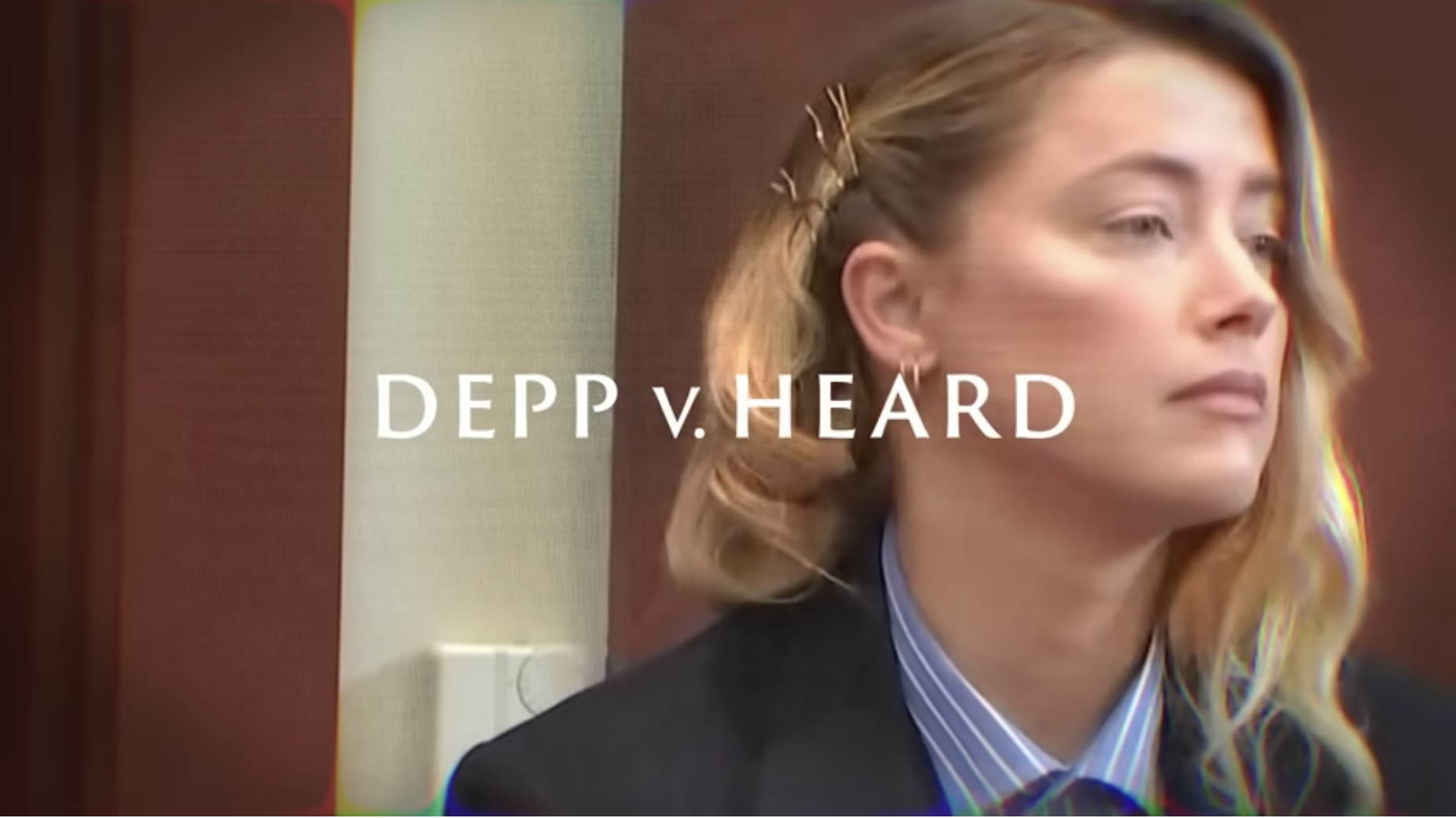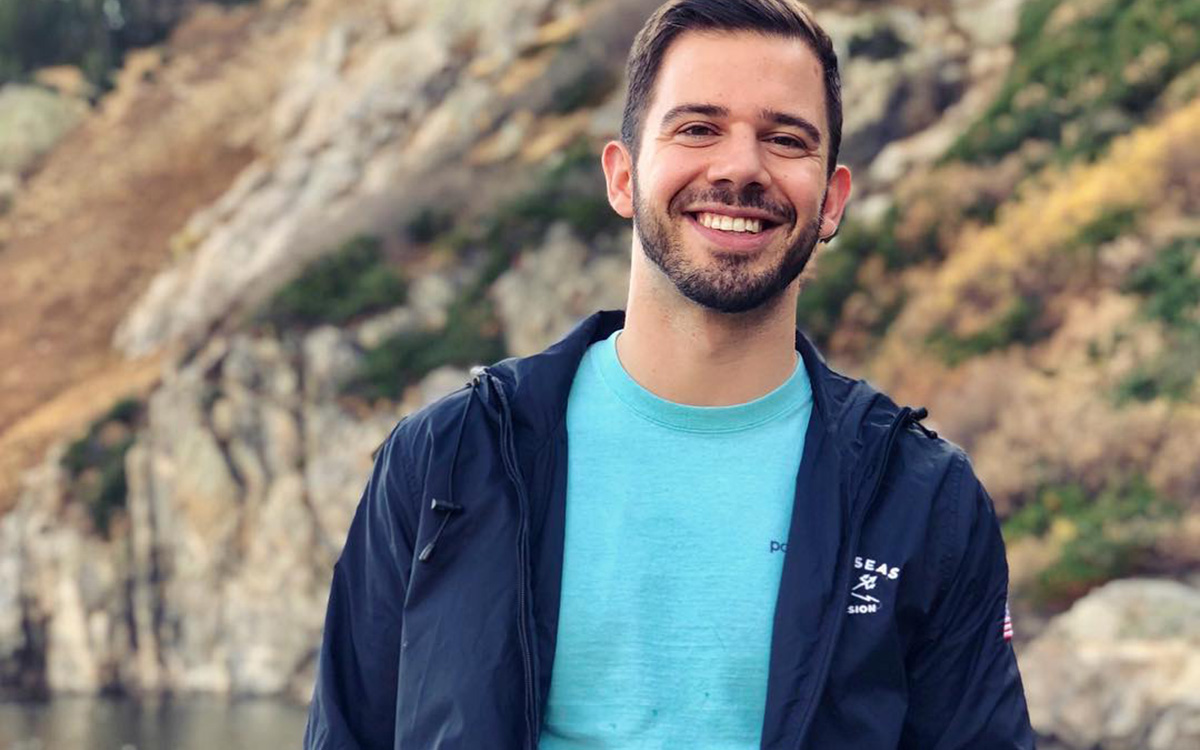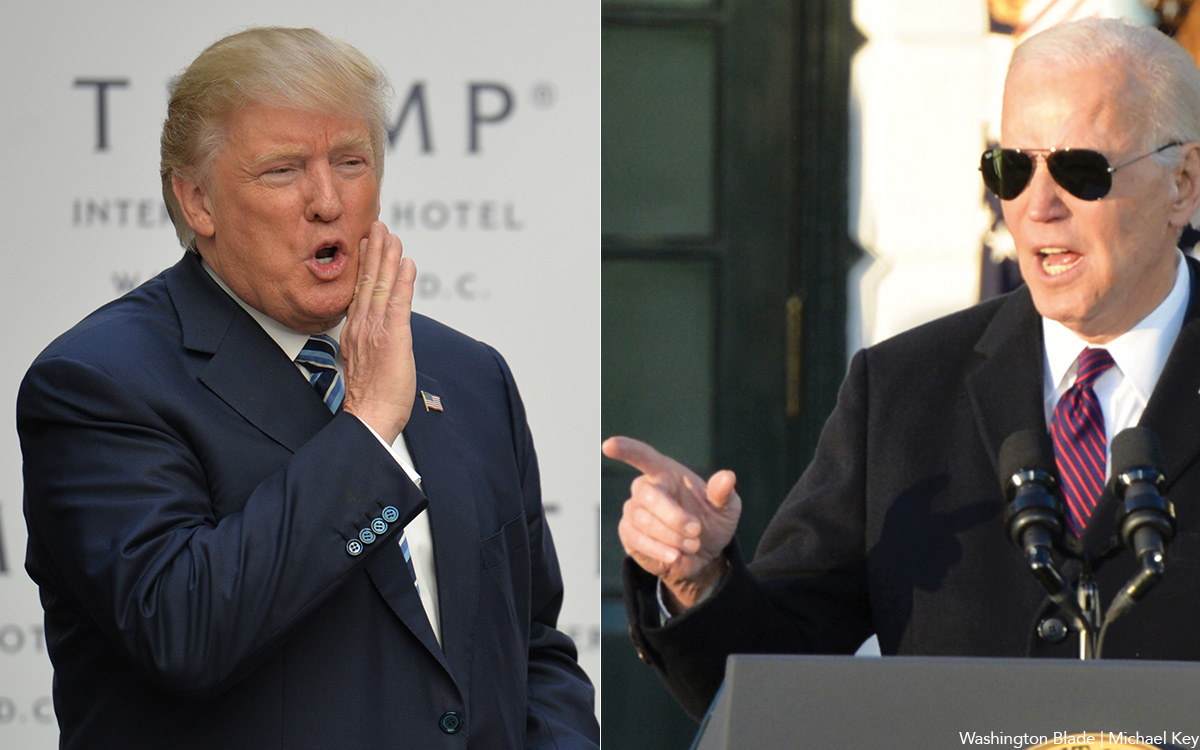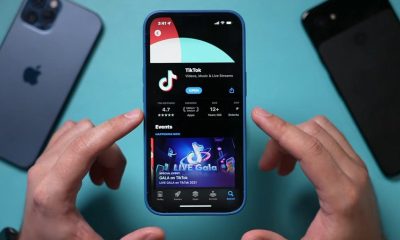Opinions
Johnny Depp, Amber Heard and the deeply unsatisfying matter of re-litigating their trial
The series was panned by critics

On Aug. 16, Netflix released a three-part docuseries revisiting last summer’s televised civil litigation over allegations that Amber Heard had defamed ex-husband Johnny Depp by claiming to have survived sexual violence and domestic abuse during their four-year relationship.
Rather than offering anything new by way of insight or analysis from anyone with relevant qualifications or experience, each episode features clips from some of the online “creators” who turned their hot takes on the trial into a veritable cottage industry of amateur legal commentary and courtroom conspiracy theories, feeding the rapacious demand for anti-Heard and pro-Depp content. (As if to underscore the project’s unseriousness, these included a men’s rights YouTuber who wore a Deadpool mask and was surrounded by Spider-Man costumes.)
Worse still, “Depp v. Heard” director Emma Cooper fails not only to answer but also to even ask the obvious questions that have lingered since a verdict was returned more than 14 months ago by seven jurors in northern Virginia who were not sequestered as the case became, by far, the most popular topic on social media and online platforms.
At the same time, however, the episodes include footage of courtroom testimony that offer a glimpse, though incomplete, into some of the trial’s more salient and dispositive moments that I otherwise would never have seen (with neither the time nor the inclination, either last year or now, to follow 120+ hours of argument by the parties presented over the course of a seven-week trial.)
Do these scenes redeem the series? Hardly. But that does not mean they offer nothing of value, especially considering that while this was not the retelling of last summer’s events that we deserve, it remains the only one we’ve got. At least, for now.
Susan Sontag, in her 1977 collection of essays “On Photography,” proclaimed “The camera makes everyone a tourist in other people’s reality, and eventually in one’s own.”
In “Depp v. Heard,” the cameras facilitate a very specific kind of tourism that feels both exploitative and voyeuristic, because the reality in which we find ourselves trespassing is dark: the unraveling of a relationship between movie stars through patterns of dysfunction and abuse both familiar and alien, knowable and unknowable, like a city you have visited but never called home.
Especially when coupled with the more outrageous moments from trial that made headlines at the time – such as the debate over whether Heard defecated on Depp’s bed and blamed his teacup Yorkshire Terrier – there is a temptation to treat footage of testimony concerning the smashing of liquor bottles and hurling of wine glasses, the shoving and taunting and threats, even the physical and sexual violence, as though it were pure spectacle.
However, this would suggest, wrongly, that the painful realities of the actors’ relationship are so far removed from our lived experiences that we do not, cannot, or should not relate to them. As if a seven-week trial adjudicating the conflicts in our own intimate relationships or those involving the people we love would not turn up evidence of trouble and dysfunction, or worse.
Considering that we are primed to pick winners and losers and heroes and villains, perhaps it was unsurprising that incomplete and selectively edited footage from the case provided ample fodder for Instagram reels and TikTok videos that were created in the service of narratives that, most often, favored Depp and vilified Heard.
For me, witnessing these scenes in their proper context revealed a picture so much more complicated and, frankly, ugly that the prospect of framing the case in this manner seemed as preposterous as the idea that audiences leaving a production of “Who’s Afraid of Virginia Woolf” should find themselves allied with either Martha or George.
To take just one example: From the witness stand, Heard recounted how she would often return home to their shared Los Angeles penthouse to find Depp nodding off in a chair because he had washed Roxicodone down with whiskey, or lying supine on the sofa fully unconscious with melted ice cream pooled in his lap. Worried about her husband’s apparent substance use disorder and unsure how best to help, the actress admitted she would sometimes take photos of him and share the pictures with a trusted friend.
Or, Depp’s attorney asked, was she just trying to humiliate him? Or, online commentators asked (often rhetorically), was this a calculated and premeditated move to collect evidence she would use against Depp in litigation or for purposes of extorting him?
As if these motives are mutually exclusive.
Having experienced the pain of watching loved ones spiraling in the throes of drug and alcohol addiction, I can tell you why I suspect Heard took the photos, but of course the reality is neither I nor anyone else – perhaps not even she – has any clue.
Last year, so much of the online noise about the trial came from content creators who made specious arguments to poke holes in the credibility of Heard’s testimony or alleged ulterior, sinister hidden motives based on the actress’s countenance, demeanor, speech, and other behavior.
For example, in clips that were often selectively edited or presented outside of their proper context, Heard might have seemed to cry more hysterically upon realizing the cameras were trained on her, which were used as supposed proof that her claims of suffering abuse at the hands of her ex-husband must therefore be fabricated.
Watching the footage in the manner presented on screen in “Depp v. Heard,” it becomes even more obvious how silly these interpretations were. In reality, of course, no one – not even police officers, trial court judges, F.B.I. and C.I.A. agents, trial lawyers or forensic psychiatrists – can reliably spot when someone is lying to them.
However convincing some YouTuber may have been, and however comforting the idea that we are able to see through the lies of others, I’m sorry to tell you the research on this is overwhelming and uncontested.
As Malcolm Gladwell observes in “Talking to Strangers,” Amanda Knox was falsely convicted for a murder she did not commit because “much of the prosecution’s case…rested on the allegedly strange, guilty behavior she exhibited,” which “the public deemed not in line with typical responses to grief and trauma.”
The cameras did not tell the complete story.
Well before 2022, private details about Depp and Heard’s troubled relationship had spilled onto the pages of tabloids like The Sun, which called Depp a “wife beater” in a 2018 story alleging that “overwhelming evidence was filed to show Johnny Depp engaged in domestic violence against his wife.” After he sued the paper for defamation, London’s High Court of Justice ruled against the actor in 2020, concluding the claims at issue were “substantially true.”
Still, last summer’s litigation between the actors earned far more public attention and unearthed far more (and far more titillating) private information, causing, therefore, far more damage than the supermarket rags and gossip blogs – as well as, ironically, the financial and reputational damage resulting from the very defamation claims that were adjudicated at trial.
As a reminder, Depp sued his ex-wife for a 2018 opinion article in the Washington Post in which she had written, “two years ago, I became a public figure representing domestic abuse, and I felt the full force of our culture’s wrath for women who speak out.” Heard was referencing the backlash against, essentially, identical claims she made in a statement after securing a restraining order against Depp following their divorce in 2016. (“During the entirety of our relationship, Johnny has been verbally and physically abusive to me,” she wrote.)
In so many cases including this one, intimate partner abuse is messy. An audio recording of one of the couple’s arguments shows Heard acknowledging she had struck her ex-husband but denying that she punched him. Her testimony, meanwhile, detailed serious violent crimes, including that Depp had thrown her into a ping pong table and repeatedly hit her in the face before sexually assaulting her with a liquor bottle that may have been broken.
Of course, assuming their sworn testimony to be true, it must also be said, domestic violence is a gendered crime. And the imbalanced power dynamics within their relationship put Heard at a disadvantage, including in this respect. While both are famous actors, the wealth, power, and fame wielded by Depp was then (and remains, now) much greater.
The disparity was evident from the outset. In the Netflix series, throngs of fans are shown cheering the Pirates of the Caribbean star and booing Heard on the first day they were sighted arriving separately to the Fairfax County Circuit Court. Meanwhile, online, evidence of a sustained and coordinated character assassination of Heard had just begun to emerge.
The smear campaign would persist through the trial and beyond. The actress was called a manipulative liar, a gold digger, an abuser, a violent psychopath, a drug addict, and worse. Some of the most outrageous claims were among the most widely circulated: She snorted cocaine on the witness stand, killed her own mother to conceal testimony that would have exonerated Depp, plagiarized lines from the film The Talented Mr. Ripley.
Creators mocked Heard by lip-synching over audio of her testimony about suffering violent abuse in videos that went viral on TikTok along with hashtags like #JusticeForJohnnyDepp, which was seen nearly 3 billion times on the platform. (#justiceforamberheard earned just 25 million views.) One-sided articles and videos, many containing false and misleading claims, were promoted by Ben Shapiro’s conservative media outlet The Daily Wire through its estimated $35,000 and $47,000 purchase of Facebook and Instagram ads.
“Depp v. Heard” was panned by critics.
“If ever a true-crime documentary needed the usual collection of talking-head interviews with esteemed journalists, law enforcement veterans and legal experts to put things in perspective,” Richard Roeper of the Chicago Sun Times wrote, “this is it — but that never happens.”
Others, like CNN’s Brian Lowry, agreed: “How much is gained from listening to a guy in a Deadpool mask offering extensive trial takes is a question ‘Depp v. Heard’ should have contemplated and apparently didn’t,” he wrote.
Several reviews added that part of the problem was that not nearly enough time had elapsed between the events and their retelling. Bustle’s Scaachi Koul pointed to other recent projects involving the private lives of public figures (especially women) that, with sufficient space and distance, found new and interesting things to say about their subjects and opportunities to tell their stories anew.
Ryan White’s excellent documentary “Pamela: A Love Story,” which was released by Netflix in January, manages to find plenty of material about actress and model Pamela Anderson along with the broader sociocultural forces of the 90s and early aughts that helped shape – and were shaped by – the era’s most enduring sex symbol.
The film would have been nothing, however, without Anderson. Listening to her tell her own story, one realizes how poorly suited everyone else was to the task – particularly the leering talk show hosts and journalists who treated her as nothing more than a sex object.
And maybe that, above all else, is the lesson to be gleaned from “Depp v. Heard”: Let’s come back to this story, sure, when we’re ready to cut through the bullshit, reframe the conversation away from the “him vs. her” framing, stop relying on provably unreliable evidence, and consider the broader context of their relationship and the impact of the trial that happened on TikTok and YouTube. And let’s definitely listen to Heard if and when she’s ready to talk about this again.
Until we get that docuseries (or documentary, scripted series, film, book, whatever), I fear everything else will be deeply unsatisfactory and unsatisfying.
Opinions
Successful open relationships take effort
We have options as couples but they all require work

(Editor’s note: This is the second of a two-part feature on open relationships. Click here for last week’s installment.)
Open relationships are often ridiculed as the easy way out of commitment. After speaking with Scott and Kelsey, however, it’s clear they’re anything but easy.
Kelsey reflected on the ups and downs of being open in the past. “Younger me definitely needed it,” Kelsey said. “At the same time, drama came with it as well.”
While Scott and their partner have been together for nine years, it took four before they decided to open their relationship. “It came from the desire for the two of us to meet boys together,” said Scott. “Then we had some really terrible threesomes.”
Drama. Bad threesomes. Yikes – these aren’t exactly selling points for being open. But their experiences underscore something important: open relationships, like all relationships, are actually quite hard. Couples considering openness shouldn’t trick themselves into thinking it will make things easier. In reality, they take a lot of work.
For Scott, those really terrible threesomes led them to opening up further, but with established boundaries. “We came up with ground rules. Use protection. No spending the night at somebody’s house, etc.”
Since Scott and their partner are happy in their relationship, these rules seem to work even if they’ve shifted over time. “Being in an open relationship comes down to being really good at communicating with your partner,” they added. “It’s about communicating and checking in to see where your partner is.”
Open relationships should be for the right reasons
As open relationships began taking off, observers were skeptical for good reason. “In the past, people were just cheating,” said Kelsey. Another comment from Scott echoed this. “I’ve seen open relationships and it felt like one partner was being taken advantage of by the other.”
It turns out there is a fine line between sexual exploration and free passes. While some open relationships walk that line well, others – not so much.
In all fairness, now more than ever it’s difficult to remain monogamous, and one culprit is the rise of accessible hookup culture via social media. Apps like Tinder, Grindr, and dare I say Instagram are facilitating secret sexual connections never seen before. They ushered in a new era of cheating into relationships, alongside a bit of excessive stalking as well.
So, to avoid an atmosphere of mistrust and pain, a natural evolution for couples is to change the rules altogether. Cheating can’t be cheating if it’s allowed, right?
However, once it is allowed, I wondered why these people don’t cut the strings altogether and be single. In response, Chad made an interesting point: people aren’t just afraid of being cheated on – they’re afraid of the appearance of being single as well. We live in flashy times where our online image means everything. The dream is not necessarily having a partner, but showing the world you have a partner. Without that, you otherwise appear lonely.
So, do open relationships ease the pain of cheating and perceived loneliness? As a proud lone wolf I’m not the best person to assess, but based on my observations I can say this: being open works for some couples, but by no means is it a fast pass to being happy. Understanding why you want one is just as important as discovering how to make one work.
With all this said, the undeniable risk – and perhaps downside – of a monogamous coupling is the higher chance of cheating outright. Unfortunately, that’s something Chad knows all too well.
Preferring monogamy is still OK
Chad had dated someone for two years before they married for five. Then, just over a year into the pandemic, his husband informed him he was dating someone else. They separated a few days later.
For Chad this was painful, as it is for anyone, gay or straight, who’s gone through something similar. But when I asked him if this experience shaped his outlook on what he’s looking for, his response came as a bit of a surprise:
“It has not changed my view for or against open relationships,” he said. “I learned a lot in my marriage. It takes a lot of love, trust, and communication, which at times can feel like work. It also takes two; one can’t carry the relationship. I want to date someone who wants to be in a relationship with me.”
My heart swells hearing that, for even after experiencing the deepest kind of hurt, Chad searches for his one and only. Why? Because for him, the love he’s looking for is worth the wait. It’s a beautiful sentiment that makes so-called hopeless romanticism the raddest feeling in the world sometimes.
More importantly, Chad doesn’t let fear alter his view on love, and to me that’s the most important lesson of this article. Love always comes with risks, and lowering your standards to reduce them never really pans out, does it? The best we can do is to be ourselves.
By the way, this is a lesson I should also apply. My main hesitation toward an open relationship is that I’m a jealous bitch, and I fear that jealousy will never go away. Yet this can be hard to admit when everyone around you is propping up a culture where open is supreme and jealousy is immature.
When I brought this up to Kelsey, she pushed back with a simple question: “Do you think jealousy is a bad thing?”
This caught me off guard. “I’m not sure,” I replied. “Do you?”
“Jealousy is a natural, human emotion,” she said. “It’s what you do with it that matters.”
So, maybe my goal is not to suppress my jealousy but rather be upfront about it. If it’s part of me, I should own it, then ideally find someone who loves me regardless.
Changing your mind is OK, too
In gay man speak, I was a top for my first seven years before I embraced bottoming. For some, they’d be shocked to hear it. Yet maybe no one should be surprised, for as we all know sexuality is fluid, and this applies to more than just your orientation. Your sexual preferences can shift over time, too, and this will inevitably affect your relationships.
This was the case for Scott and their partner. “When we first started dating, we did not want to be open,” they mentioned, “but as our relationship grew, we decided to reevaluate that.” Meanwhile, Kelsey went the opposite direction – she was open back in the day but chooses to be closed now.
Even Chad remains open to being open. “I’m not opposed to an open relationship, but I feel like it would take more work. I just don’t see myself starting a relationship open. The first few years there is a lot of learning about each other.”
In a world of shifting preferences, the best we can do is reflect on what we want and be honest about it. Life is a process of discovering who we are, and damn is it messy. So, perhaps I should cut some slack to the couple trying things out. And perhaps they can cut me slack for not understanding their rules.
For the couples: remember, a solid relationship is not only about meeting the needs of your partner, because your needs matter, too. The best relationships, open or closed, strive to find that balance.
For those still searching: remember that love is more than just that thing, that connection, that spark. In fact, love is so complex that the “spark” is just one of many factors, alongside timing and how you want to be loved, that come together and form an imprint as unique and special as the person you want to be with.
In this sense, open and closed relationships aren’t diametrically opposed but rather complimentary, a sort of yin and yang where both become better because the other option exists. Today, we have options as couples, and that’s significantly better than abiding by rules because we assume that’s how it must be.
And that feels right. Because regardless of whether you’re more a Chad or a Scott, the truth is: I feel lucky to have both.
(Writer’s note: A big thank you you to Chad, Scott, and Kelsey for allowing me to share their stories.)
Jake Stewart is a D.C.-based writer and barback.
Opinions
Fact: The next president will be Biden or Trump
One candidate is clearly better for the future of the world

Like it or not, the next president will be either Joe Biden or Donald Trump. In our system, third-party candidates are simply spoilers, they don’t win. The last time a third-party candidate won was 1856. It has been 36 years since a third-party candidate even got more than 5% of the vote. So, it’s time to face reality and choose; for your future, do you want Biden or Trump?
I was prompted to write this column because I see the media interviewing young people about who they want as their president. I have great respect for the young people of today. In many ways, they are smarter than my generation was. But it’s clear, some don’t fully understand the presidential election process. I hear many complain about Biden, and then follow that up and say they will never vote for Trump. Some then say they will vote for a third-party candidate. They need to understand their third-party candidate will not win, but their vote could help elect Trump. I hate to say it, but in 2024, voting for a third-party candidate is the equivalent to flushing your ballot down the toilet.
I am an unabashed Biden supporter. I see the great things he has done, including: getting us through the fallout from the pandemic, passing an infrastructure bill, forgiving billions in student loans, ensuring our economy is the best in the world with more than 13 million jobs created, and increasing wages. He supports unions, being the first president to walk a picket line with the UAW. His administration is working to deal with climate change. He is fighting for a woman’s right to control her own body and healthcare, and supports full equality for the LGBTQ community. In this dangerous world he has kept our troops out of war.
Then there is Trump. To be clear; I see him as a racist, sexist, misogynistic, homophobic, pig. OK, so maybe I don’t have strong feelings about him. Trump has been found liable for sexual assault and has been indicted on 91 counts. He proudly claims credit for having taken away control of their body and healthcare from women, when the justices he appointed ended Roe v. Wade. He supports states making decisions on abortion, and we see what recently happened in Arizona. He is a climate change denier and is opposed to wind and solar power. He wants to give more tax deductions to the rich and to corporations, while opposing any increase in the minimum wage. He opposes equality for the LGBTQ community, refusing to endorse the Equality Act. He opposes student debt relief.
You may see these candidates differently, and that is OK. But if you like one more than the other, fear one more than the other, or just aren’t enamored by either, you must still make a choice and vote for one of them. Staying home is abrogating your civic responsibility, and especially if you would never vote for Trump, understand your staying home helps him.
Young voters, like all voters, should take the time to do the research on both candidates. Then match what you find as close as possible to what you want to see as your future. If you want student loan relief, equality for the LGBTQ community, women having control of their body and healthcare, equal pay for women, efforts to ameliorate the impact of climate change, then clearly Trump is not your candidate.
I hear some young people say they won’t vote for Biden because of his positions on the Israel/Hamas war. I, too, have called for Israel to recalibrate how they fight this war. But I ask you to look again at Trump’s history of attachment to Netanyahu, even going so far as relocating the U.S. embassy to Jerusalem. If you want a chance for the Palestinian people to live in peace and prosperity, for Israel to remove their settlements from the West Bank, your chance of having that happen is clearly better with Biden than Trump. Don’t let your emotions today, cloud the reality of the future.
Yes, Biden is old, but so is Trump. He apparently can’t even stay awake at his own trial having nodded off two days in a row. So, since one of them will be president, with no third-party candidate having a chance, I urge you to look at them again, in a realistic way. Then make your choice. I think you may come to the same conclusion I have. Though not perfect, and no one is, Biden is the better candidate for your future, and for the future of the world.
Peter Rosenstein is a longtime LGBTQ rights and Democratic Party activist. He writes regularly for the Blade.

In 2023, the law was signed to expand the District’s medical cannabis program. It also made permanent provisions allowing residents ages 21 and older to self-certify as medical cannabis patients. Overall, cannabis is fully legal in D.C. for medical and recreational use, and 4/20 Day is widely celebrated.
Medical cannabis, for example, has a long history with the LGBTQ community, and they have often been one of the oldest supporters of marijuana and some of the most enthusiastic consumers. Cannabis use also has a long history of easing the pain of the LGBTQ community as relief from HIV symptoms and as a method of coping with rejection from society.
The cannabis culture continues to grow in the District, and as a result, so does the influence on younger people, even youth within the LGBTQ community. Drug education can play an important role and should not be avoided during 4/20 Day. Parents and educators can use drug education to help their kids understand the risks involved with using marijuana at a young age.
According to DC Health Matters, marijuana use among high school students has been on the decline in the District since 2017. In 2021, it was estimated that around 20% of high school students use marijuana, a drop from 33% in 2017. Nationally, in 2020, approximately 41.3% of sexual minority adults 18 and older reported past-year marijuana use, compared to 18.7% of the overall adult population.
When parents and educators engage with their kids about marijuana, consider keeping the conversations age appropriate. Speaking with a five-year-old is much different than speaking with a teenager. Use language and examples a child or teen would understand.
The goal is to educate them about the risks and dangers of using cannabis at a young age and what to avoid, such as edibles.
Most important, put yourself in your kid’s shoes. This can be especially important for teenagers as they face different social pressures and situations at school, with peer groups, or through social media. Make a point of understanding what they are up against.
When speaking to them about cannabis, stay calm and relaxed, stay positive, don’t lecture, and be clear and concise about boundaries without using scare tactics or threats.
Yet, it’s OK to set rules, guidelines, and expectations; create rules together as a family or class. Parents and educators can be clear about the consequences without lecturing but clearly stating what is expected regarding cannabis use.
Moreover, choose informal times to have conversations about cannabis and do not make a big thing about it. Yet, continue talking to them as they age, and let them know you are always there for them.
Finally, speak to them about peer pressure and talk with them about having an exit plan when they are offered marijuana. Peer pressure is powerful among youth, and having a plan to avoid drug use helps children and students make better choices. Ultimately, it is about assisting them in making good choices as they age.
Members of the LGBTQ community often enter treatment with more severe substance use disorders. Preventative measures involving drug education are effective in helping youth make good choices and learn about the risks.
Marcel Gemme is the founder of SUPE and has been helping people struggling with substance use for over 20 years. His work focuses on a threefold approach: education, prevention, and rehabilitation.
-

 State Department4 days ago
State Department4 days agoState Department releases annual human rights report
-

 District of Columbia2 days ago
District of Columbia2 days agoCatching up with the asexuals and aromantics of D.C.
-

 South America2 days ago
South America2 days agoArgentina government dismisses transgender public sector employees
-

 Politics5 days ago
Politics5 days agoSmithsonian staff concerned about future of LGBTQ programming amid GOP scrutiny












